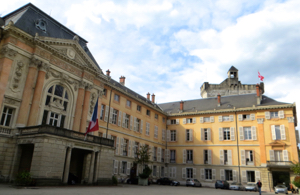 |
What to See & Do in Chambéry, France | |
| Chambéry's main sights are clustered around its compact Old Town. | ||
|
|
|
Chambéry, the historic capital of Savoy, maintains the flavor of bygone days in its old town. Serving as the residence of the Dukes and Counts of Savoy from 1232 to 1563, it has been witness to many changes. The Halles, or covered market, is just around the corner from the Tourist Information Office and serves as an entry to the old town. From there you can stroll the narrow streets, many of which are limited to pedestrians, and admire the architecture. The most significant structure is the Château of the Dukes of Savoy, which towers over the old town. The Château complex consists of a variety of buildings, some dating from the Middle Ages and others more modern. Some are used today as administrative buildings, while others form the historical Château. In the 16th century the Sainte Chapelle housed the Holy Shroud, which was later moved to Turin. From May until September you can enjoy a guided visit of the Château.
From the Château, wander down any of the narrow streets.The Rue Basse du Château (the Street Below the Château) is a narrow Medieval street that has one of the few remaining enclosed overhead footbridges. It is marked by a colorful sign that dates it to the 14th century. Rue Basse du Château is home to a number of shops and restaurants. The Rue de Boigne is known for its Turin-style porticos. It was constructed by—and named for—General Benoît de Boigne, who was from Savoy and made his reputation in India before retiring to Chambéry and engaging in charity work. The Cathédrale St François de Sales dates from the 13th century. It is known for its unique and large collection of trompe l'oeil paintings, said to be the largest collection in Europe. Just next door to the Cathédrale, in the former convent, is the small Musée Savoisien. It focuses on the history, archaeology, ethnography, and art of the region. Chambéry is home to several other impressive museums. The Musée des Beaux Arts, or Fine Arts Museum, has large collections of Italian paintings from the 14th to the 18th century, as well as 19th and 20th century works from the Chambéry School. Behind the Château is the Natural History Museum, with its collections of minerals and zoological and geological specimens. (Note: limited opening on Wednesdays and first Sunday of the month.) Perhaps the best known monument in Chambéry is the Fountain of the Elephants, at the intersection of Rue de Boigne and Boulevard de la Colonne. The elephants are said to represent the military campaigns in India that were led by General de Boigne. Chambéry is conveniently located on the western edge of the Alps, just 18 kilometers (11 miles) south of Aix-les-Bains; only 11 kilometers (7 miles) south of the Lac du Bourget; and 59 kilometers (37 miles) north of Grenoble.
|
|

Above, Some of the colorful buildings of the Château des Ducs de Savoie.
|

